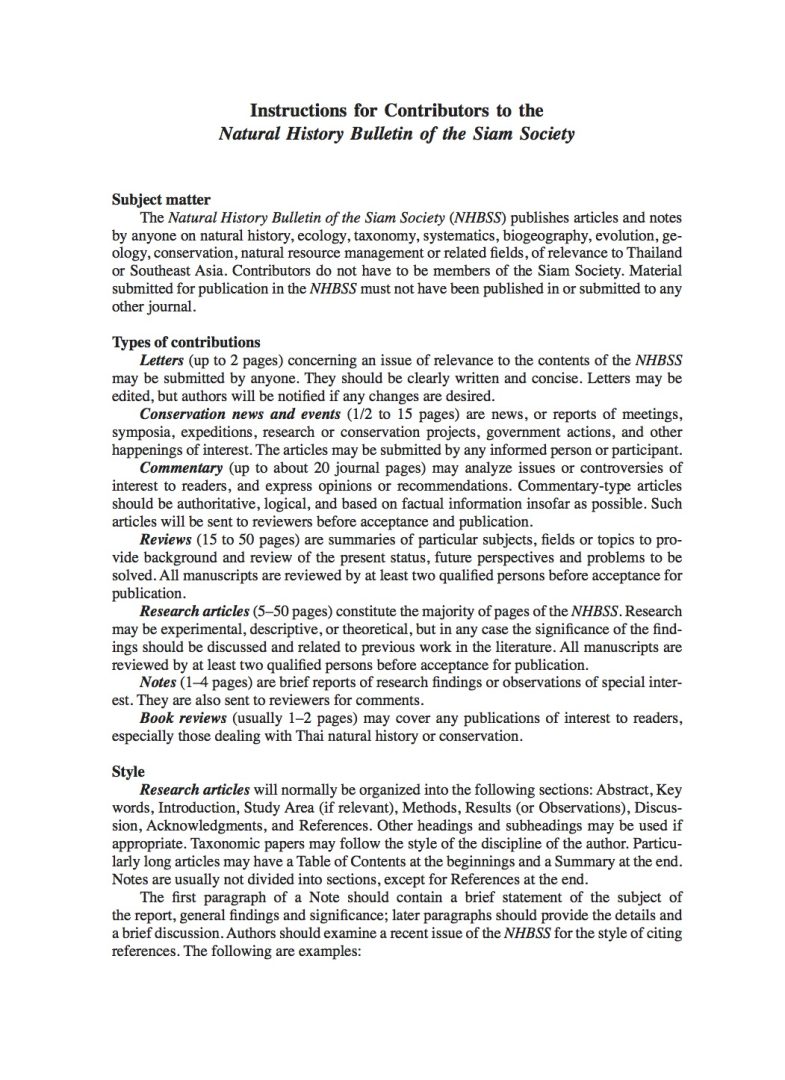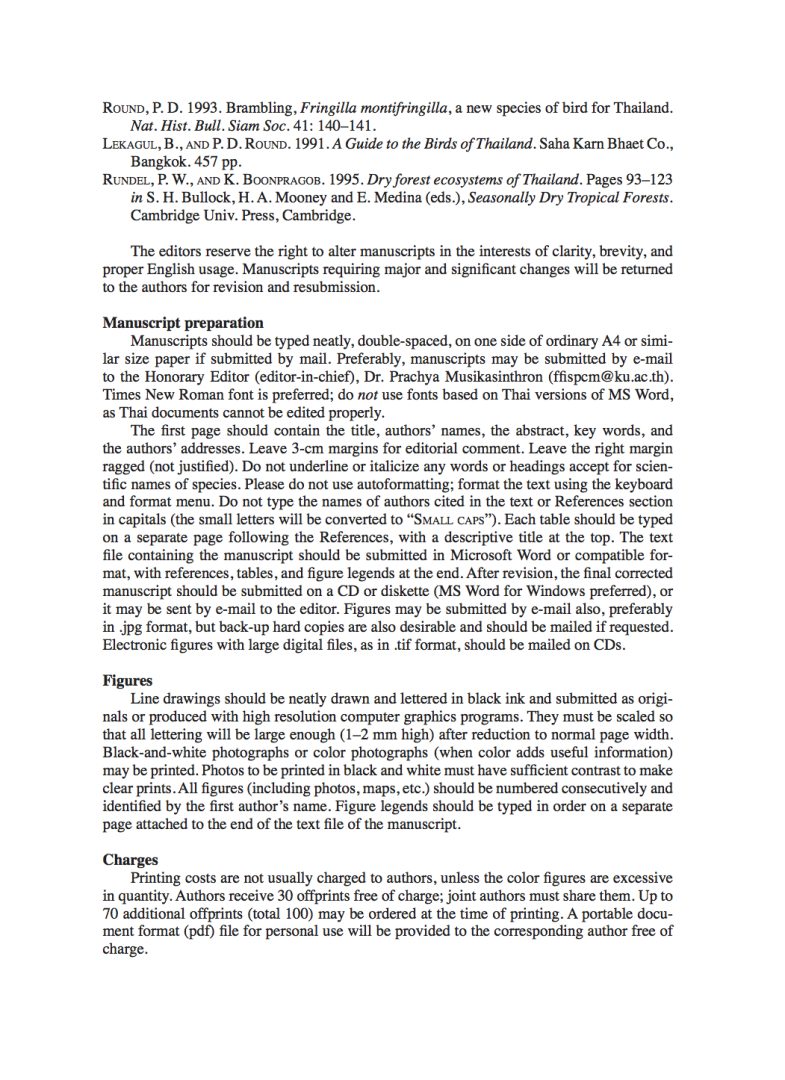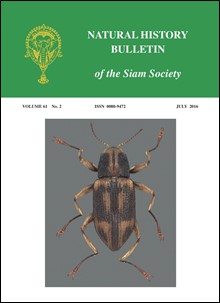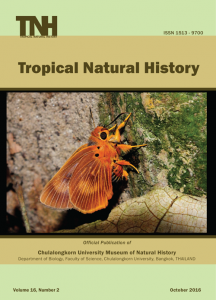คำแนะนำการเขียนเอกสารฉบับเต็ม
การประชุม “การบริหารจัดการความหลากหลายทางชีวภาพแห่งชาติ ครั้งนี้ 4” ทางผู้จัดจะจัดส่งผลงานทางวิชาการที่ได้รับการคัดเลือก ไปยังวารสารที่ได้รับการยอมรับในฐานข้อมูลศูนย์ดัชนีการอ้างอิงวารสารไทย (TCI) เพื่อพิจารณาในการตีพิมพ์ ได้แก่
| ลำดับ | ISSN | ชื่อไทย | ชื่ออังกฤษ | เจ้าของ | อยู่ในฐานข้อมูล | รายละเอียด |
| 1 | 1513-9700 | Tropical Natural History | Tropical Natural History | Department of Biology, Faculty of Science, Chulalongkorn University | Zoological Record | วารสาร Tropical Natural History ได้รับการจัดอันดับจากศูนย์ดัชนีการอ้างอิงวารสารไทย ให้เป็นวารสารระดับชาติ ในกลุ่มที่ 1 (เป็น 1 ใน 189 วารสารสาขาวิทยาศาสตร์ที่ผ่านการประเมิน) และจะถูกคัดเลือกเข้าสู่ฐานข้อมูล ASEAN Citation Index (ACI) |
| 2 | 0080-9462 | The Natural History Bulletin of the Siam Society | The Natural History Bulletin of the Siam Society | The Siam Society | Biological Abstracts, Zoological Record |
ขั้นตอนการส่งผลงาน
1. ผู้สนใจส่งเอกสารฉบับเต็มมายังฝ่ายเลขานุการจัดประชุม พร้อมระบุวารสารที่จะส่งผลงาน โดยเลือกเพียงวารสารใดวารสารหนึ่งเท่านั้น (TNH หรือ NHBSS)
2. จัดทำผลงานทางวิชาการตามรูปแบบที่วารสารกำหนด สามารถดูแบบฟอร์มการเขียนผลงานได้ที่เว็บไซต์ของวารสาร
- วารสาร Tropical Natural History (TNH) http://www.biology.sc.chula.ac.th/TNH/
- วารสาร The Natural History Bulletin of the Siam Society (NHBSS) http://www.siam-society.org/pub_NHB/nhb_index.html
3. ผลงานฉบับเต็มจะผ่านการพิจารณาเบื้องต้นจากคณะกรรมการจัดประชุมด้านวิชาการ และจะถูกส่งไปยังวารสารที่ท่านเลือกเข้าสู่ขั้นตอนตามกระบวนการพิจารณาของวารสารนั้นๆ
4. สามารถส่งผลงานฉบับเต็มได้ภายในวันที่ 31 มีนาคม 2560 โดยส่งมาที่อีเมล์ biod@biotec.or.th หรือโทรสอบถามฝ่ายจัดประชุมวิชาการ 02-6448150 ต่อ 81844, 81845
Instructions to TNH authors.
Aim and Scope:
Tropical Natural History [former The Natural History Journal of Chulalongkorn University (NHJCU)] is a journal publishing original research, review and interactive natural history. Manuscripts considered include papers on experimental biology, systematic, ecology, paleontology, and the interaction of organisms with their environment.
Initial submission:
Manuscripts are accepted for a review with the understanding that the same work has not been published or being offered for publication elsewhere. All manuscripts will be subjected to peer review before acceptance. Manuscripts should be written in clear and grammatically correct English. Text must be typed in double- spaced throughout the manuscript. The manuscripts submitted should be by e-mail attachment in MSWord (for figures in the PDF format) to the Editor by somsakp@sc.chula.ac.th or somsak_panha@yahoo.com
Final submission:
Following acceptance, the author must submit one paper copy of the revised manuscripts, an identical electronic copy of the text (on CD, in Microsoft Word), tables (on separate page), and original figures (if possible) publication-quality electronic copies of the figures (TIFF or JPEG). Manuscripts must be submitted to the Editor.
General Presentation:
The first page of the manuscripts should include title; authors’ names and their full postal address(es), and e- mail address of corresponding author. This should be followed by: Abstract (about 200 words) (on separate page), which is a brief, but informative summary of the contents and the conclusions of the
paper. Keywords (3-5 worlds) should be listed immediately after the abstract. The main text should consist of: Introduction, Materials and Methods, Results (or Systematic Descriptions), Discussion or Conclusion, Acknowledge-ments, Literature Cited, Tables and Figure
Legends. Each page should be Arabic numbered sequentially. In the methods section, experimental procedures should be described in sufficient details, which enable the work to be repeated. Hierarchy of headings should not normally exceed two: main headings (centered, small capitals) and subsidiary headings (on the left, in bold). Do not number headings and avoid footnotes.
Nomenclature and Systematic Descriptions:
Italicize the names of genera, subgenera and species. When first mentioned, specific names should include the authority. Descriptions of new taxa and taxonomic revisions must comply with the ICBN or ICZN. Headings for all taxonomic categories in taxonomic papers should be centered and in bold. They should optimally include, in the following order: Synonymy; Types; Etymology (for new taxa); Material Examined; Diagnosis; Description; Distribution; Remarks. Synonymies should be in ‘condensed’ format, following on chronologically. Full references to the authors cited in synonymies must appear in the final reference list. Diagnoses and descriptions should be given in ‘telegraphic’ style, or full sentences. Whenever possible, authors are advised to deposit type specimens in national or international public museums or collections.
Tables:
Tables should be typed, each on a separate sheet, numbered consecutively with Arabic numerals in order of appearance in the text (as ‘Table 1′), and with the title (in the format: ‘Table 1. List of localities…..’). Each table should be given a short descriptive title directly above it, with any footnotes (in superscript lowercase letters) directly below the table.
Illustrations:
The text page size available is 145×200 mm with the text set in two columns each 70 mm wide. Illustrations or figures should be prepared such that they fit into a single column (70 mm wide), two columns, or occupy a full page (140×180 mm figure size). All illustrations should be referred to in the text as ‘Fig. or Figs’ in parentheses and with Arabic numerals. Illustrations may be either drawings or photographs, which can be accepted in Adobe Photoshop compatible formats and saved in JPEG format with a resolution of 800 dpi and 600 dpi respectively. Graphics, such as line figures with text, can be accepted as TIFF format. Each component of a composite figure should be given a bold capital letter; labels, and abbreviations should be in bold lower-case letters with optimal size. Colour figures can be published at the authors’ expense. Colour figures must be saved as CMYK colour mode. Original illustrations should only be submitted following final acceptance, unless electronic copies are requested for final submission. Illustrations must each carry a scale bar and not magnifications. The caption format for composite figures should be, for
example: Figure 1. Littorina littorea. A. Pallial oviduct. B. Penis. Abbreviations: ag, albumen gland; sg, sperm groove. Scale bars: A = 2.0 mm; B = 1.0 mm.
Literature Cited:
Include only published or in-press articles. Dissertations resulting from graduate studies and non-serial proceedings of conferences/symposia are to be treated as books. References should be referred to in the text
as Red and Blue (2000), Red et al. (2000) for 3, or more authors or (Red, 2000; Blue and Red, 2000; Red et al., 2000) in the parentheses. All literature cited in the text must be listed alphabetically in the following formats:
Journal paper: Red, A.A., Blue, B.B. and Green, C.C. 2000. Title of the paper. Title of the journal in full, 12: 31-35.
Book chapter: Red, A.A., Blue, B.B. and Green, C.C. 2000. Title of the Chapter. In: Red, A.A. (Ed.) or Red, A.A., Blue, B.B. and Green, C.C. (Eds) (for 2 or more authors). Title of Book, Publisher name and location, page range.
Book: Red, A.A. and Blue, B.B. 2000. Title of Book, Publisher name and location, number of pages (e.g. 123 pp).
Internet resources: Red, A.A. and Blue, B.B. 2000. Title of website or database, Publisher name and location, number of pages. Available from: http://xxx.xxx.xxx/, (Date of access). Repeat authors’ names and journal titles in multiple entries and avoid ibid.
Research Notes and Review:
Short manuscripts approximately 3000 words are also accepted. They are normally interim results from projects in progress or on subjects of exceptional interest and complete in their own right. These papers should be written Nature style, contain no more than two figures and two tables, without abstract, and briefly acknowledgements. References in the text should be cited only by a superscript number, and listed at the end of the paper in the order they appear in the text. The first pages should be contained as in article. The names of journals abbreviated in standard form (see World List of Scientific Periodicals). Review papers are accepted. These papers do not contain much new data, but rather the authoritative and critical review of the current knowledge regarding various aspects of natural history.
Proofs, Offprints, and Copyright:
One set of proofs will be sent (by e-mail and paper copy) to the corresponding author only; it is assumed that only printer’s errors and factual mistakes will be corrected. Contributors will receive 25 free offprints and additional copies may be purchased and ordered in multiples of 50.





